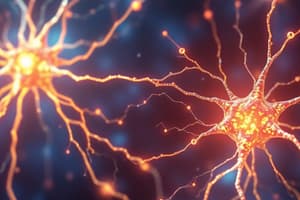Podcast
Questions and Answers
What type of synapse allows free movement of ions between neurons through small protein tubular structures called gap junctions?
What type of synapse allows free movement of ions between neurons through small protein tubular structures called gap junctions?
- Axonal synapse
- Chemical synapse
- Electrical synapse (correct)
- Neurotransmitter synapse
In chemical synapses, the first neuron secretes a chemical substance called a neurotransmitter into a gap known as the:
In chemical synapses, the first neuron secretes a chemical substance called a neurotransmitter into a gap known as the:
- Communication cleft
- Neuronal cleft
- Synaptic gap (correct)
- Neurotransmitter cleft
Which synapse type can transmit signals more slowly but allows for both excitatory and inhibitory actions?
Which synapse type can transmit signals more slowly but allows for both excitatory and inhibitory actions?
- Biological synapse
- Polarizing synapse
- Chemical synapse (correct)
- Depolarizing synapse
What is the part of a neuron conducting an action potential towards another neuron called?
What is the part of a neuron conducting an action potential towards another neuron called?
Which synapse is associated with complex human behaviors such as learning and memory?
Which synapse is associated with complex human behaviors such as learning and memory?
What structure in a presynaptic neuron is filled with neurotransmitters and releases them into the synaptic cleft during signal transmission?
What structure in a presynaptic neuron is filled with neurotransmitters and releases them into the synaptic cleft during signal transmission?
What is synaptic potentiation?
What is synaptic potentiation?
How do chemically gated channels (NMDA receptors) contribute to synaptic potentiation?
How do chemically gated channels (NMDA receptors) contribute to synaptic potentiation?
What is the result of presynaptic inhibition?
What is the result of presynaptic inhibition?
How are neurotransmitters classified based on their effects?
How are neurotransmitters classified based on their effects?
What distinguishes channel-linked receptors from G protein-linked receptors in terms of neurotransmitter action?
What distinguishes channel-linked receptors from G protein-linked receptors in terms of neurotransmitter action?
How many different neurotransmitters have been identified so far?
How many different neurotransmitters have been identified so far?
What is the main function of an inhibitory postsynaptic potential (IPSP)?
What is the main function of an inhibitory postsynaptic potential (IPSP)?
What is the primary ion involved in inhibitory synapses?
What is the primary ion involved in inhibitory synapses?
What happens during temporal summation in synaptic transmission?
What happens during temporal summation in synaptic transmission?
How does spatial summation contribute to neuronal excitation?
How does spatial summation contribute to neuronal excitation?
What does it mean when a neuron is 'facilitated'?
What does it mean when a neuron is 'facilitated'?
How does rapid rate of stimulation affect postsynaptic potential?
How does rapid rate of stimulation affect postsynaptic potential?
Flashcards are hidden until you start studying




